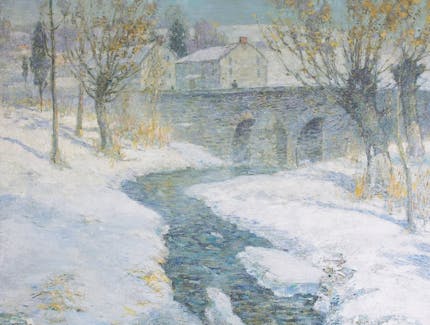Paul King
1867 - 1953

Paul King
1867 - 1953
Paul King was born in Buffalo, New York in 1867. King's father, Bernard H. King, was a goldsmith and taught his son many things about composition, color and texture, even though his medium of choice was much different from that of his son's future means of expression. When he was sixteen Paul King took up lithography, a form that allowed him to fine-tune his skills as a draftsman. He was a skilled printer. King began studying at the Buffalo Art Students League shortly after its founding in 1891. While in Buffalo, he worked alongside artists such as Eugene Speicher, Edward Dufner and George Bridgman. From 1901 through 1904, King studied life drawing at the Art Students League in New York under H. Siddons Mowbray. To make ends meet as a student, King worked as an illustrator for magazines such as Harpers and Life. By this time, King had already been exposed to Impressionism, through both the Art Student's League and from the 1901 Pan-American Exposition that came through Buffalo. In 1905, King traveled abroad to Europe where he studied in France, Italy and Holland. In Holland, he studied with Evert Pieters and Bernard Bloomers. It was also on this particular trip abroad that King was likely exposed to the Fauves. Although he would remain a fairly traditional painter throughout his career, this early exposure to a very unique and modern group of artists, allowed King to break away a bit from the very conservative way he approached painting. When he returned to the United States, King received quite an honor when he received two awards from the Salmagundi Club (Shaw Prize and Inness Prize) for the painting, Hauling the Anchor Line (location unknown). King established a studio in Philadelphia and from there submitted his work to a wide range of national exhibitions. He sent work to the Art Institute of Chicago, the Pennsylvania Academy of the Fine Arts, the Corcoran Gallery, the Carnegie Internationals, and the Panama Pacific International Exposition (where he won a silver medal). He also exhibited at the Casson Galleries and the Woodward Art Gallery, both in Boston, as well as the Ferargil Galleries. Paul King was a board member at the Philadelphia School of Design for Women, serving as both the vice president and acting president from 1908- 1921. He established a summer studio in Stony Brook, Long Island in the early 1920s. He moved there permanently from his home in the Germantown section of Philadelphia in 1921. In 1933, he was named full academician at the National Academy of Design. He continued to paint through the 1930s and early 1940s, even though Impressionism has lost much of its appeal among the public. Paul King died at age eighty-six.

